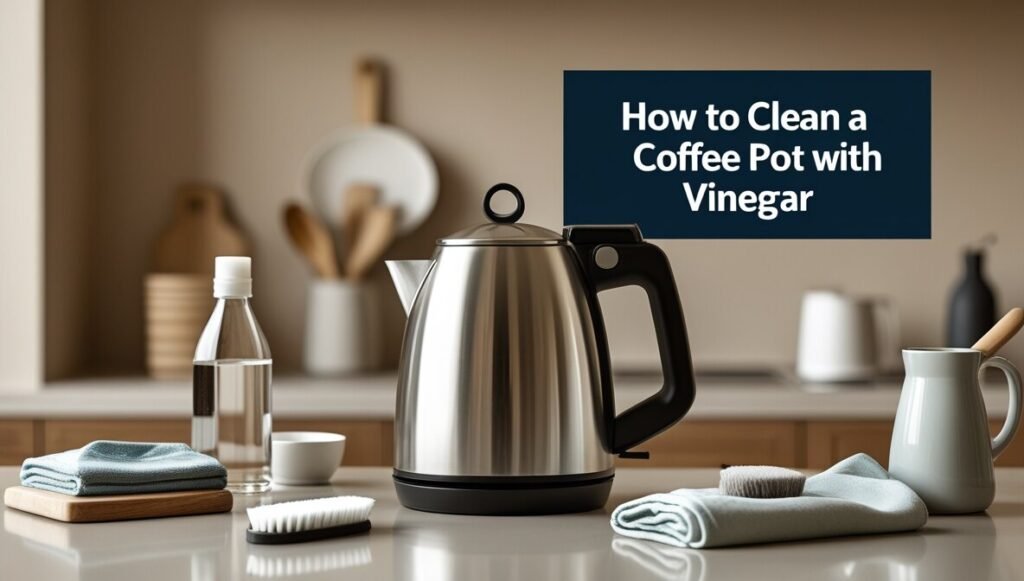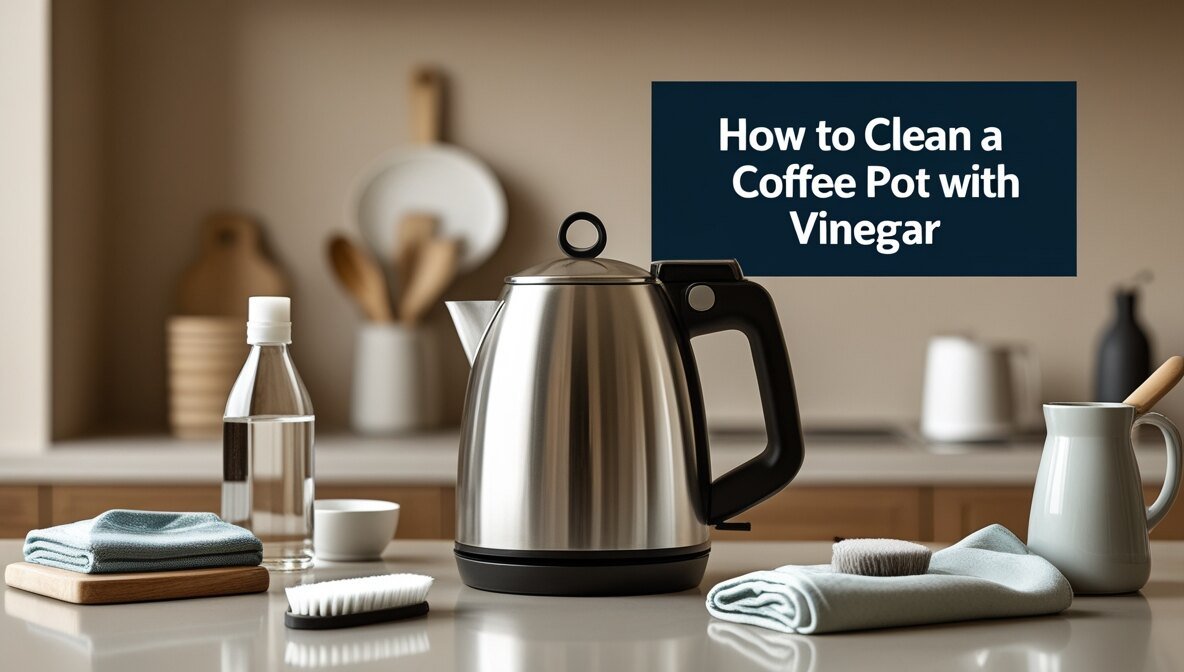A clean coffee pot is essential for brewing the best-tasting coffee and maintaining the longevity of your machine. Over time, mineral deposits, coffee oils, and residue can accumulate, affecting the flavor of your brew and potentially clogging your coffee maker. Regular cleaning ensures that every cup of coffee is as fresh and delicious as it should be.
One of the most effective and affordable ways to maintain your coffee maker is by using white vinegar. Known for its natural cleaning properties, vinegar can dissolve buildup, sanitize the coffee pot, and keep your machine running smoothly—all without harsh chemicals.
In this guide, we’ll walk you through how to clean a coffee pot with vinegar, step by step. This vinegar coffee pot cleaning method is simple, budget-friendly, and an essential part of coffee pot maintenance. Whether you’re using a standard coffee maker or a specialty machine, vinegar is the go-to solution for keeping your coffee maker in top condition. Let’s get started and ensure your coffee tastes its best!

Why Cleaning Your Coffee Pot Is Important
Keeping your coffee pot clean is more than just a good habit—it’s essential for enjoying flavorful coffee and extending the life of your machine. Over time, coffee grounds, oils, and mineral deposits accumulate inside the pot and machine, leading to a host of issues that can affect performance and taste.
Common Issues from Neglecting Coffee Pot Maintenance
- Coffee Residue: Oils from coffee grounds cling to the pot and internal components, leaving behind a residue that can turn rancid. This affects the flavor of your coffee, making it taste bitter or stale.
- Mineral Buildup: Hard water leaves deposits inside the coffee maker, clogging water lines and reducing efficiency. These deposits can interfere with water flow and heating, leading to inconsistent brewing.
- Bacteria and Mold: A moist environment inside the coffee maker is the perfect breeding ground for bacteria and mold, which not only affect taste but can also pose health risks.
The Impact of Skipping Maintenance
Neglecting to clean your coffee maker can significantly impact both the quality of your coffee and the lifespan of your machine:
- Flavor Issues: Residue and buildup change the flavor profile of your coffee, masking the rich, fresh taste with bitterness and off-notes.
- Reduced Performance: Mineral deposits and clogs force the machine to work harder, leading to inefficiency, potential malfunctions, and a shorter lifespan.
- Health Concerns: Mold and bacteria in a dirty coffee pot can contaminate your coffee, turning your morning ritual into a health hazard.
The Role of Vinegar in Coffee Pot Cleaning
Using coffee maker with vinegar as your cleaning solution is an effective way to tackle all these problems. Vinegar dissolves mineral buildup, sanitizes surfaces, and removes residue, ensuring a clean and safe brewing process. After cleaning, always rinse thoroughly with water to remove any lingering vinegar scent or taste.
Regularly cleaning your coffee pot ensures every cup is fresh, flavorful, and safe to drink. By incorporating coffee pot residue removal into your routine, you’ll enjoy better-tasting coffee and a machine that lasts longer.
What Tools You’ll Need for Cleaning a Coffee Maker
To ensure your coffee maker stays in top condition, having the right tools and supplies is essential. These items are simple, readily available, and perfect for maintaining your machine using natural cleaning methods. Here’s a breakdown of the coffee pot cleaning supplies you’ll need and why they’re ideal for the job.
Essential Supplies for Cleaning Your Coffee Maker
- White Vinegar
- The star of any natural cleaning routine, white vinegar is highly effective for removing mineral deposits, sanitizing surfaces, and breaking down coffee residue. Its acidity makes it a powerful, non-toxic option to descale your coffee maker.
- Water
- Used to dilute the vinegar and for rinsing after cleaning. A proper balance of white vinegar and water ensures safe and effective cleaning without leaving behind a strong vinegar scent.
- Dish Soap (Optional)
- Mild dish soap can help remove stubborn coffee oils and stains from the carafe or external surfaces. It’s a good addition to deep-cleaning sessions.
- Sponge or Brush
- A sponge or soft brush is essential for scrubbing the coffee pot and components, like the carafe and basket. Use a brush with soft bristles to avoid scratching delicate surfaces.
- Microfiber Cloth or Paper Towels
- These are perfect for wiping down and drying your coffee maker after cleaning. Microfiber cloths are particularly effective at picking up residue and leaving surfaces streak-free.
Why These Tools Are Ideal for Cleaning Coffee Pots
- Safe and Natural: Using vinegar to clean ensures a non-toxic, environmentally friendly approach to maintaining your coffee maker.
- Effective for Buildup Removal: This combination of supplies tackles both mineral deposits and coffee oils, ensuring thorough cleaning.
- Gentle on Components: The sponge, brush, and microfiber cloth are gentle enough to protect your coffee maker’s surfaces while providing a deep clean.
- Budget-Friendly: All these supplies are inexpensive and commonly found in most households, making them a cost-effective solution.
By using these coffee pot cleaning supplies, you can keep your coffee maker in excellent condition, ensuring every brew is fresh and flavorful. Whether you’re performing regular maintenance or a deep clean to descale your machine, these tools will make the process easy and effective.
Step-by-Step Guide to Clean a Coffee Pot with Vinegar
Keeping your coffee maker clean with a coffee pot vinegar solution is an easy and effective way to ensure better-tasting coffee and a longer-lasting machine. Follow these steps to deep-clean your coffee pot and enjoy the freshest brews every time.
1. Prepare the Cleaning Solution
- Mix equal parts white vinegar and water in the coffee pot.
- The amount depends on the size of your coffee maker’s reservoir—use just enough vinegar solution to fill it completely.
This simple mixture is the foundation of natural cleaning and works effectively to dissolve buildup and sanitize your coffee maker.
2. Start the Cleaning Process
- Pour the vinegar solution into the coffee maker’s reservoir, as if you’re preparing to brew a pot of coffee.
- Begin the brewing cycle, but stop the brew cycle halfway through to allow the solution to work on mineral deposits and coffee oils.
- Let the vinegar-water solution sit for 15–20 minutes. This pause gives the vinegar enough time to dissolve stubborn buildup inside the coffee machine.
3. Complete the Brewing Cycle
- After soaking, restart the coffee maker and allow it to finish the brewing process.
- Once done, dump out the vinegar mixture from the coffee pot. Be sure to inspect the interior of the coffee maker and reservoir for any remaining residue.
4. Rinse and Remove Residue
- Fill the reservoir with fresh water and run 2–3 brew cycles of clean water. This step eliminates any lingering vinegar solution taste or smell.
- If needed, wash the coffee pot, filter basket, and other removable parts with dish soap to ensure every component is spotless.
5. Clean the Exterior
- Use a damp microfiber cloth to clean the coffee maker’s exterior, wiping away smudges, stains, or drips.
- Pay attention to buttons and crevices where grime can accumulate.
Pro Tips for Success
- If you don’t have white vinegar, apple cider vinegar can be used as a substitute, though it may leave a slight scent.
- Make it a habit to perform this time to clean routine once a month, especially if you use hard water.
- Replace the coffee filter with a fresh one after cleaning for the best results.
Using white vinegar to clean your coffee pot ensures a naturally effective and budget-friendly maintenance routine. With these steps, your coffee machine will run efficiently, delivering fresh and flavorful coffee every day!
How Often Should You Clean Your Coffee Pot?
Maintaining a clean coffee pot is key to great-tasting coffee and a long-lasting machine. Here’s a breakdown of how often to perform routine and deep cleaning tasks:
Daily Maintenance
- Rinse After Every Use: After brewing a pot of coffee, rinse the coffee pot, filter basket, and any removable parts with warm water. This prevents coffee oils and residue from building up, making coffee maker maintenance easier over time.
Monthly Deep Cleaning
- Perform a deep clean using a vinegar solution once a month to remove mineral deposits, coffee stains, and bacteria. This keeps your coffee maker running efficiently and ensures every brew tastes fresh.
- If you have hard water, consider deep cleaning more frequently to prevent buildup and clogs.
By knowing how often to clean your coffee pot, you’ll maintain optimal performance and enjoy consistently delicious coffee.
Tips for Better Coffee Pot Maintenance
Regular care ensures your coffee maker remains in excellent condition while minimizing the need for extensive cleaning. Follow these simple tips for effective upkeep:
1. Use Filtered Water
- Using filtered or distilled water minimizes mineral deposits that can clog your machine and affect its performance. It’s a simple yet effective way to prevent hard water buildup and extend the time between cleanings.
2. Clean the Filter Basket and Removable Parts
- Wash the filter basket, carafe, and other removable components regularly with warm soapy water. This prevents coffee stains and residue from accumulating.
3. Keep the Coffee Pot Lid Open
- After cleaning, leave the coffee pot lid open to allow air circulation and prevent moisture buildup. This step helps the pot dry completely and reduces the risk of mold and mildew.
4. Avoid Leaving Coffee Sitting
- Don’t leave coffee in the pot for extended periods. Stale coffee can stain the carafe and affect the taste of future brews.
By incorporating these coffee maker care tips into your routine, you can prevent coffee pot stains and ensure every cup is as good as the first. A little regular attention goes a long way in maintaining your machine and elevating your coffee experience.
7. Eco-Friendly Benefits of Cleaning with Vinegar
Cleaning your coffee pot with vinegar offers more than just effectiveness—it’s an environmentally conscious choice that benefits both your home and the planet. This simple, natural coffee pot cleaning method is safe, sustainable, and perfect for eco-minded coffee lovers.
Why Vinegar is the Ultimate Eco-Friendly Cleaning Solution
- Non-Toxic and Safe
- Unlike many commercial cleaners, vinegar is free of harsh chemicals and synthetic fragrances, making it safe for use around food and drink-related appliances like coffee makers.
- Its non-toxic nature protects your health and reduces the risk of chemical residue contaminating your coffee.
- Biodegradable and Sustainable
- Vinegar is derived from natural sources and breaks down easily in the environment, leaving no harmful residues behind.
- Using vinegar instead of chemical cleaners prevents toxic pollutants from entering waterways and affecting aquatic life.
- Budget-Friendly and Accessible
- A bottle of white vinegar costs far less than most commercial descaling products, making it a cost-effective option for natural coffee pot cleaning.
- Widely available and versatile, vinegar can be used for multiple household cleaning tasks, reducing the need for multiple products.
How Vinegar Compares to Commercial Cleaners
| Feature | Vinegar | Commercial Cleaners |
|---|---|---|
| Eco-Friendliness | Biodegradable and natural | Often contain non-biodegradable chemicals. |
| Cost | Affordable and readily available | More expensive and less versatile. |
| Safety | Non-toxic, safe for food areas | May include harsh or toxic ingredients. |
| Effectiveness | Dissolves mineral buildup and sanitizes | Effective but may require additional rinsing to remove chemical residues. |
Eco-Friendly Cleaning Hacks with Vinegar
- Use vinegar for not only cleaning your coffee pot but also other areas of your kitchen, such as kettles, dishwashers, and sinks.
- Pair vinegar with baking soda to tackle tougher stains and odors naturally, avoiding chemical-laden alternatives.
Conclusion
Cleaning your coffee pot doesn’t have to be a chore—using vinegar makes the process simple, effective, and eco-friendly. This guide on how to clean a coffee pot with vinegar shows how a natural, budget-friendly solution can remove stubborn residue, descale mineral buildup, and sanitize your machine effortlessly.
Regular cleaning using the best coffee cleaning methods ensures better-tasting coffee, improved water flow, and a longer lifespan for your coffee maker. Whether you incorporate daily rinsing or a monthly deep-clean routine, taking care of your coffee pot guarantees a fresher brew every time.
Ready to experience the difference? Try this vinegar cleaning method and enjoy a cleaner, better-performing coffee machine. Don’t forget to share this post with fellow coffee lovers and leave a comment with your results—we’d love to hear how it worked for you!
Can I use apple cider vinegar instead of white vinegar?
Yes, apple cider vinegar can be used as an alternative to white vinegar for cleaning your coffee pot. However, it may leave a stronger scent and slight residue compared to white vinegar, which is why white vinegar is generally preferred. If you choose apple cider vinegar, be sure to rinse thoroughly with clean water to remove any lingering odor or taste.
Will vinegar damage my coffee maker?
No, vinegar is safe to use for cleaning most coffee makers. Its natural acidity effectively removes mineral buildup without harming the internal components. However, excessive or undiluted vinegar use might be too harsh for some machines. Always dilute vinegar with water (1:1 ratio) and follow the manufacturer’s recommendations for cleaning.
Can I use this method for all types of coffee machines?
Yes, the vinegar cleaning method is safe for most types of coffee makers, including drip machines, single-serve systems, and espresso machines. However, if your machine has specific care instructions, consult the user manual to ensure vinegar is suitable. Some high-end or specialty coffee machines may have unique cleaning requirements.

Anamika is a passionate writer for Eco365Store.com, specializing in topics that inspire a cleaner, greener world. With expertise in home cleaning, recycling, and eco-friendly solutions, she crafts engaging and informative articles that help readers adopt sustainable practices in their daily lives.

